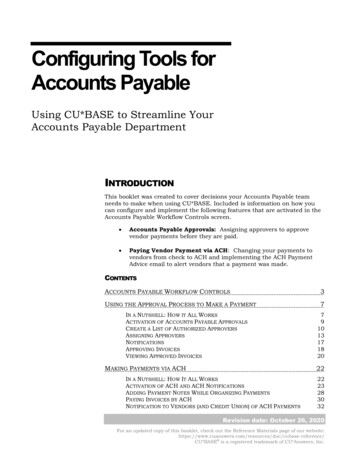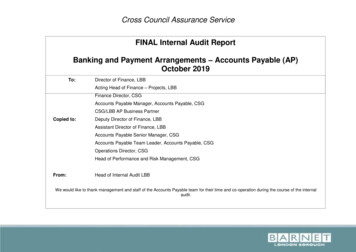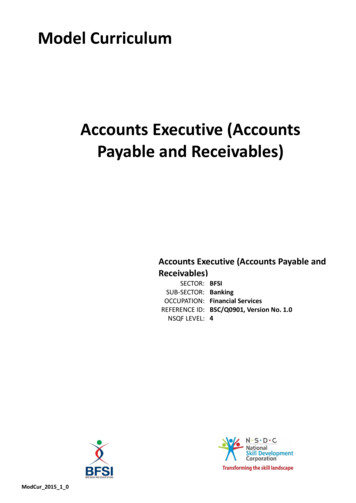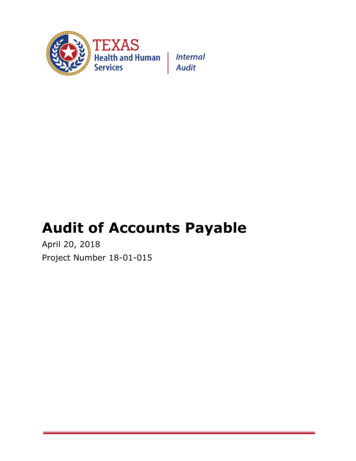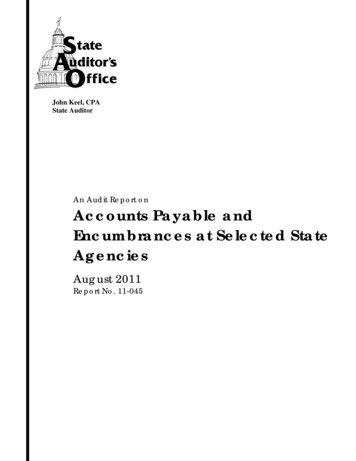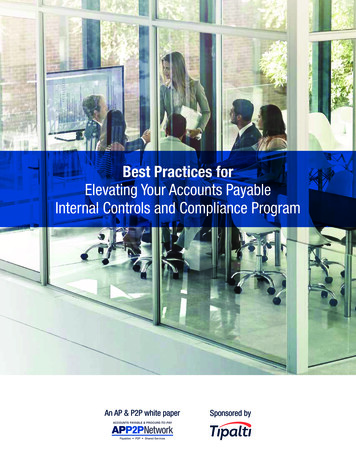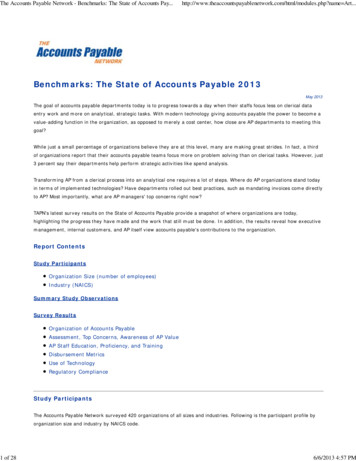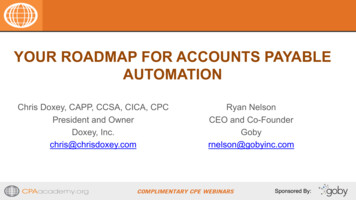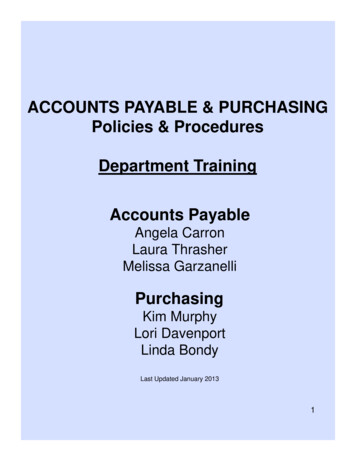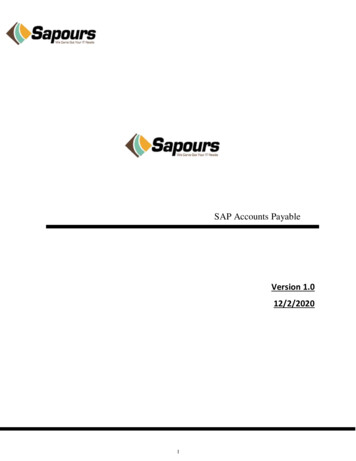
Transcription
Introduction to Accounts Payable in ARC
COPYRIGHT & TRADEMARKSCopyright 1998, 2009, Oracle and/or its affiliates. All rights reserved.Oracle is a registered trademark of Oracle Corporation and/or its affiliates. Other namesmay be trademarks of their respective owners.This software and related documentation are provided under a license agreementcontaining restrictions on use and disclosure and are protected by intellectual propertylaws. Except as expressly permitted in your license agreement or allowed by law, youmay not use, copy, reproduce, translate, broadcast, modify, license, transmit, distribute,exhibit, perform, publish or display any part, in any form, or by any means. Reverseengineering, disassembly, or decompilation of this software, unless required by law forinteroperability, is prohibited.The information contained herein is subject to change without notice and is not warrantedto be error-free. If you find any errors, please report them to us in writing.If this software or related documentation is delivered to the U.S. Government or anyonelicensing it on behalf of the U.S. Government, the following notice is applicable:U.S. GOVERNMENT RIGHTSPrograms, software, databases, and related documentation and technical data delivered toU.S. Government customers are “commercial computer software” or “commercialtechnical data” pursuant to the applicable Federal Acquisition Regulation and agencyspecific supplemental regulations. As such, the use, duplication, disclosure, modification,and adaptation shall be subject to the restrictions and license terms set forth in theapplicable Government contract, and, to the extent applicable by the terms of theGovernment contract, the additional rights set forth in FAR 52.227-19, CommercialComputer Software License (December 2007). Oracle USA, Inc., 500 Oracle Parkway,Redwood City, CA 94065.This software is developed for general use in a variety of information managementapplications. It is not developed or intended for use in any inherently dangerousapplications, including applications which may create a risk of personal injury. If you usethis software in dangerous applications, then you shall be responsible to take allappropriate fail-safe, backup, redundancy and other measures to ensure the safe use ofthis software. Oracle Corporation and its affiliates disclaim any liability for any damagescaused by use of this software in dangerous applications.This software and documentation may provide access to or information on content,products and services from third parties. Oracle Corporation and its affiliates are notresponsible for and expressly disclaim all warranties of any kind with respect to thirdparty content, products and services. Oracle Corporation and its affiliates will not beresponsible for any loss, costs, or damages incurred due to your access to or use of thirdparty content, products or services.
Training GuideIntroduction to Accounts Payable in ARCTable of ContentsIntroduction to Accounts Payable in ARC . 2Introduction to Accounts Payable in ARC . 3Accounts Payable Overview .4Accounts Payable Curriculum . 5ARC Roles and Responsibilities . 6What's Changing? . 7Accounts Payable Roles and Responsibilities . 8Vendor Process Overview. 9Voucher Process Overview . 10Payment Processing . 11Tax Compliance . 12P-Card Reconciliation and Maintenance . 13Vendor Navigation Overview . 14Requesting/Modifying Vendors . 15Viewing Vendors . 16Voucher Navigation Overview . 29Voucher Styles . 30ChartFields and ChartStrings . 31Creating Vouchers . 32Accessing Voucher Related Documents . 51Accounts Payable Inquiry Overview . 64Accounts Payable Inquiry . 65Approval History . 84Accounts Payable System Integration . 93ARC Module System Integration . 94OnBase System Integration. 95Course References . 96Key Terms . 97Check Your Understanding . 98Answer Key . 99Glossary . 100Page iii
Training GuideIntroduction to Accounts Payable in ARCPage 1
Training GuideIntroduction to Accounts Payable in ARCIntroduction to Accounts Payable in ARCPage 2
Training GuideIntroduction to Accounts Payable in ARCIntroduction to Accounts Payable in ARCThis is the Introduction to Accounts Payable in ARC course within the Accounts Payablecurriculum.If you need a reminder on how to navigate through this course using ARC's web-based trainingtool (WBT), click here for a quick reference guide.Page 3
Training GuideIntroduction to Accounts Payable in ARCAccounts Payable OverviewThis is the Introduction to Accounts Payable Overview lesson of the Introduction to AccountsPayable in ARC course. Upon completion of this lesson, you will be able to: Describe the end-to-end Accounts Payable business process and highlight key processand system changes occurring with the transition from the legacy systems to ARCReview the benefits of ARC's new Accounts Payable module and processesIdentify the roles involved in the new ARC Accounts Payable processes and understandthe key Accounts Payable activities performed by each of these rolesEstimated time needed to complete lesson: 20 MinutesPage 4
Training GuideIntroduction to Accounts Payable in ARCAccounts Payable CurriculumThe Introduction to Accounts Payable in ARC course will provide an overview of the corecomponents that comprise the Accounts Payable module in ARC and provides the following keyfunctionality: Robust transaction workflow both within departments and between departments andcentral Accounts PayableDisbursement of payments to vendors and payeesRobust tax coding to ensure proper tax withholding and reportingIntegration with Purchasing for encumbrance management and with the General LedgerDirect access to data on accounts payable transactions and integrated reporting onaccounts payable transactions and the full procurement transaction lifecycleIn addition, the course will provide key navigation basics within the Accounts Payable module.The components within the Accounts Payable module in ARC are as follows:For additional detail and demonstrations regarding the components, you may access the FinanceGateway Training Directory.Page 5
Training GuideIntroduction to Accounts Payable in ARCARC Roles and ResponsibilitiesWhile there are numerous specific roles that one can have in ARC, there are three fundamentaltypes of roles: a transaction Initiator; a transaction Approver; and an Inquirer. Each of theseroles provides access to and authority within the University’s finance system and, therefore,comes with an important set of responsibilities.Approver ResponsibilitiesSomeone with the authority to approve transactions in ARC has several responsibilities. Broadlythese responsibilities are to provide the best stewardship to University resources, conduct duediligence in the review work and related activities upon which approval is based, ensure effectiveand timely management of items awaiting approval and to be accountable for the decision toapprove a transaction or reject a transaction. Specifically, approval of a transaction in ARCsignifies: The transaction is appropriate and validThe transaction is compliant with regard to policy and budget requirementsThe transaction is correct and completeAny questions or concerns about the transaction were investigated and resolved orescalated and resolvedThe transaction was personally reviewedInitiator ResponsibilitiesSomeone with the authority to initiate/create and submit a transaction for approval in ARC hasseveral responsibilities. Broadly these responsibilities are to provide the best stewardship toUniversity resources, conduct due diligence in the activities undertaken to initiate/create atransaction and prepare it for approval, ensure effective and timely initiation of transactions inARC, and to be accountable for transactions that are initiated/created. Specifically, creation of atransaction in ARC signifies: The transaction is correct and completeAny questions or concerns about the transaction were investigated and resolved orescalated and resolvedInquirer ResponsibilitiesSomeone with the authority to make queries and view data in ARC has several responsibilities.Broadly these responsibilities are to provide the best stewardship of University resources and tobe accountable for the safeguarding of information accessed in ARC. Specific responsibilitiesinclude: Page 6Only viewing information that is required as part of one’s role and specific to atransaction or requestEnsuring appropriate security of data whenever it is exported from the system or sharedin any mannerMaintaining confidentiality of data and information
Training GuideIntroduction to Accounts Payable in ARCWhat's Changing?Today, there are a variety of systems that help Columbia University perform the activities thatcomprise the Procurement modules. In the future, ARC will replace the legacy systems andintegrate with OnBase to make for more streamlined and efficient Accounts Payable processes.ARC's integration with OnBase will have the following effects:1. Increased access to Procurement documents (requisitions, purchase orders, vouchers).OnBase's Electronic Document Management functionality will interface with ARC, sothat users can click a button in ARC and all the documents associated with a particulartransaction will be displayed.2. Increased visibility into the approval process. When Central Approvers in ProcurementServices deny a transaction or place the transaction on hold in OnBase, an e-mail willautomatically be generated from OnBase and sent to the relevant transaction initiator,indicating that the transaction has been denied or put on hold and providing detail onnecessary follow-up actions. In addition, when transactions are approved in OnBase, thisstatus will automatically be reflected in ARC.3. More streamlined and consolidated vendor process. The online vendor questionnaire willmake for a more centralized process. The online new vendor requests and modificationswill automatically be sent from the online form to OnBase. The Vendor Managementteam can review all requests within OnBase before the approved vendor records are sentfrom OnBase to ARC, making for a more efficient overall process.Page 7
Training GuideIntroduction to Accounts Payable in ARCAccounts Payable Roles and ResponsibilitiesWithin Accounts Payable, there are a variety of roles involved with creating and processingvendors, vouchers, p-card transactions, tax compliance, and payment processing. The followingcharacters will be used throughout the course to demonstrate roles, responsibilities, and workflowrouting as they relate to the Accounts Payable processes in ARC:For an end-to-end overview of the processes that make up the Accounts Payable module and aprintable version of the visuals in this training, you can reference this job aid.Page 8
Training GuideIntroduction to Accounts Payable in ARCVendor Process OverviewA vendor is anyone who is considered a payee in the new ARC system. ARC will help streamlineand improve the Vendor Management process at Columbia. Some of these benefits include: Increased consistency in vendor data though a single master vendor database thatleverages the benefits of an integrated ERP system (error checking, duplicate vendorchecking), rather than entering vendors into multiple systemsAbility to input multiple addresses for a single vendor rather than create duplicatevendors to accommodate multiple addressesNew vendor forms will enhance data accuracy and reduce the need for manual data entryby the Vendor Management Team1099 reporting criteria can be specified at the time of vendor creation, and thisinformation can be carried forward to the voucherThe new process begins with the vendor request submission process: For new vendor requests, School/Admin users along with Vendors will initiate vendoraction through submitting a vendor request form into OnBase. For vendor modifications,vendors will be able to initiate this process directlyOnBase will interface with ARC and send all Vendor Record information from OnBaseto ARCIf ARC successfully verifies that the vendor is not a duplicate and does not violate theFederal Government Financial Sanctions list, the Vendor Management Team willapprove the vendorAfter this process has been completed, a vendor is ready to be included in relevant transactions,such as requisition and voucher creation.Page 9
Training GuideIntroduction to Accounts Payable in ARCVoucher Process OverviewIn order for payments to be created in ARC, vouchers must first be entered into the system.Benefits of the new voucher creation and maintenance process include: Streamlining the voucher data entry in a single integrated system by capturing andvalidating data once at the source to eliminate unnecessary rework and follow upStreamlining the voucher approval process through workflow to create a normalizedapproval process based on a set of efficiencies and compliance criteriaImproved encumbrance liquidation and expenditure process as well as budget controlsEnsuring the flow of information throughout the entire lifecycle to address reportingneedsIntegrating with OnBase to allow for increased access to relevant documentation as wellas additional visibility into the approval processThe voucher process begins with voucher creation in ARC: Vouchers can be created manually online or using an interface of inbound voucher dataRelevant documentation can uploaded into OnBase and viewed from ARC to helpvalidate voucher information and make approval decisionsOnce a voucher has been entered and saved, the system will then initiate the matchingprocess (for PO vouchers only) to align vouchers to purchase orders and receiptsVouchers that pass the match process will move on for approval and budget checking. Ifa voucher is denied or put on hold by a Central Approver, an e-mail notification willautomatically be sent from OnBase to the Voucher Initiator so they can make relevantchangesOnce vouchers have been approved and successfully budget checked, they will be postedand paidPage 10
Training GuideIntroduction to Accounts Payable in ARCPayment ProcessingPayments are generated in ARC through the Pay Cycle Manager process. Benefits of this newpayment processing system include: ARC's Pay Cycle Manager allows for better control of payment processing by givingCentral AP the ability to create and manage paymentsLeveraging the system's ability to generate electronic payments, which streamlinespayment processing and reduces manual check processing activitiesAfter a voucher has gone through central approval and budget checking, it is able to be Posted.Once it is Posted, it will be picked up by the Pay Cycle so that a payment can be scheduled. ThePay Cycle Manager identifies transactions that are scheduled to be paid after the voucherprocessing cycle has been completed, creates and approves the payment, and finally the paymentis distributed to the vendor.The process is as follows:Page 11
Training GuideIntroduction to Accounts Payable in ARCTax ComplianceUsers with the appropriate security role will be able to use ARC's Accounts Payable module forreporting and withholding 1099 payments made to vendors. The 1099 process in ARC usesvendor payment detail data to create withholding detail records which are used to report to theIRS. Benefits of this new process include: 1099 reporting is generated from a single database source and thus will make 1099processing more accurate1099 reporting data is linked with vendor and voucher information in an integratedsystem. Vendor data is maintained in one standard file to ensure consistencyBecause tax reporting is tied to both vendors and vouchers, users with voucher-related roles at thedepartment level will have some ability to add tax-related information. When vouchers are beingcreated in ARC, users can indicate tax groups and payment preferences that will influence taxreporting. Ultimately, though, final decisions around tax reporting will be done centrally.The 1099 process in ARC is as follows:Page 12
Training GuideIntroduction to Accounts Payable in ARCP-Card Reconciliation and MaintenanceP-Card Reconciliation is the process of confirming that P-Card Transactions are legitimate,received, and assigned to the right accounts i.e. approving what has been entered by the system.In ARC, certain users will be given P-Card approver and reconciliation permissions associated toa specific cardholder(s). ARC provides the ability to: Maintain P-Card transactions in one systemObtain increased visibility into P-Card spendThe P-Card process is as follows: On a nightly basis, ARC will receive a P-Card file from Bank of America that containsall of the P-Card transactions that have been generatedThe P-Card Reconciler will then have the ability to reconcile the P-Card transactions,reallocate ChartField coding, and flag any transactions that are in dispute. In completingthese actions, they will change the status to "Verified"The P-Card Approver will review all verified transactions and provide comments asneeded. In completing these actions, they will change the status to "Approved"Note: The P-Card functionality is accessed through the Purchasing Module.Page 13
Training GuideIntroduction to Accounts Payable in ARCVendor Navigation OverviewThis is the Vendor Navigation Overview lesson of the Introduction to Accounts Payable in ARCcourse. Upon completion of this lesson, you will be able to: Access the online vendor request formSearch for existing vendor records in ARCEstimated time needed to complete lesson: 5 minutesPage 14
Training GuideIntroduction to Accounts Payable in ARCRequesting/Modifying VendorsAll vendors within the ARC system will have a vendor profile that is created to store all theinformation related to that vendor, including contact information, payment terms, and paymentmethods. Whenever Columbia University transacts with a new vendor, a vendor profile must becreated in ARC by submitting a vendor request form. The process is as follows: School/Admin users and vendors will complete and submit the vendor request formThe information obtained from the form will be downloaded to OnBase for VendorManagement to reviewOnce validated, the vendor record will be systematically generated in ARCThe Vendor Management team will then approve the vendor in ARC, enabling the vendorto be referenced on procurement transactions.The Vendor Request Form can be found on the Procurement Web Site(http://procurement.columbia.edu/).Page 15
Training GuideIntroduction to Accounts Payable in ARCViewing VendorsSometimes, users need to validate that a vendor exists in ARC or access vendor profileinformation. For example, consider this scenario: Mark requested a modification to a vendor inARC via the vendor modification request form process. Mark needs to validate that allinformation on the vendor's profile is current before selecting the vendor on a transaction. Markneeds to locate the vendor record within ARC.Estimated time needed to complete topic: 5 minutesProcedureWelcome to the Viewing Vendors Topic. Most Accounts Payable users will have read-only accessto view vendor records and information. In this topic, you will learn how to locate vendor recordswithin the ARC system.Page 16
Training GuideIntroduction to Accounts Payable in ARCStep1.Step2.ActionThere are two ways to access menu options in ARC. The first is by clicking on theappropriate option in the blue box, or you can find the same selections by clickingthe Main Menu button at the top of your screen. In this course, we will use the MainMenu button at the top of the screen.ActionClick the Main Menu button.Page 17
Training GuideIntroduction to Accounts Payable in ARCStep3.Page 18ActionClick the Vendors menu.
Training GuideIntroduction to Accounts Payable in ARCStep4.Step5.ActionClick the Vendor Information menu.ActionClick the Add/Update menu.Page 19
Training GuideIntroduction to Accounts Payable in ARCStep6.Page 20ActionClick the Review Vendors menu to locate existing vendors and review their vendorprofile information.
Training GuideIntroduction to Accounts Payable in ARCStep7.ActionClick the Name list and select the Contains list item. Click the contains list item.This is a common search tool. If you are unsure of the exact vendor name, you canenter something you know the name contains, rather than the exact name.Page 21
Training GuideIntroduction to Accounts Payable in ARCStep8.Page 22ActionClick in the Name field.
Training GuideIntroduction to Accounts Payable in ARCStep9.Step10.ActionEnter the desired information into the Name field. Enter "Supplier Vendor".ActionClick the Search button.Page 23
Training GuideIntroduction to Accounts Payable in ARCStep11.Page 24ActionNote the Vendor Identifying Information as well as the Address(es) for the vendor.
Training GuideIntroduction to Accounts Payable in ARCStep12.Step13.ActionClick the scrollbar button to view the rest of the vendor information.ActionAfter reviewing the information, scroll back to the left to access additionalinformation.Page 25
Training GuideIntroduction to Accounts Payable in ARCStep14.Page 26ActionIn order to see additional Vendor Information, click the Additional VendorInfo link.
Training GuideIntroduction to Accounts Payable in ARCStep15.ActionYou can view additional information here, such as the approval status of a vendor,whether or not withholding is required for the vendor, and if vendor is open forordering (indicating if they are eligible to be processed on Purchase Orders andrequisitions).Page 27
Training GuideIntroduction to Accounts Payable in ARCStep16.Page 28ActionYou have successfully searched for a vendor in ARC. For more information onviewing vendors, you can access the Vendor Processing Course. Now, you canselect the next lesson, Voucher Navigation Overview, where you will learn thebasics of voucher navigation.End of Procedure.
Training GuideIntroduction to Accounts Payable in ARCVoucher Navigation OverviewThis is the Voucher Navigation Overview lesson of the Introduction to Accounts Payable in ARCcourse. Upon completion of this lesson, you will be able to: Access the voucher creation pageDescribe the various voucher styles and typesDescribe the different ChartFieldsEstimated time needed to complete lesson: 10 minutesPage 29
Training GuideIntroduction to Accounts Payable in ARCVoucher Styles InvoiceCheck RequestEmployee ReimbursementTravel AdvanceCash AdvanceOGCPetty CashRefundStipendACH DebitP-CardV-PayPrepaymentVoucher Styles are used to process voucher transactions for specific purposes. The differentvoucher styles are summarized here:Page 30
Training GuideIntroduction to Accounts Payable in ARCChartFields and ChartStringsWhen creating a voucher, you will need to complete distribution line information. Thedistribution line is made up of the various ChartFields that exist in ARC. When each ChartField isselected, the associated numbers/characters for that field are joined together with otherChartFields to make up the ChartString. Each ChartField component has its own number ofcharacters. Joining these together creates a unique ChartString which dictates where the fundingfor the voucher payment is coming from within the University. The different ChartFields thatcomprise the distribution information on a voucher are as follows:For the different ChartField definitions and the FAS components they are replacing, click this jobaid. Within ARC, the ChartFields are entered on the Distribution Line, which looks like this:Page 31
Training GuideIntroduction to Accounts Payable in ARCCreating VouchersMark receives an invoice for services provided by a vendor. He needs to create a voucher in theARC system so that a payment can be generated and distributed to the vendor. The ARC voucherprocess varies based on the type of voucher users create, however, in order to start the vouchercreation process, Mark needs to navigate to the voucher creation pages.Estimated time needed to complete topic: 5 minutesProcedureWelcome to the Creating Vouchers topic. If you have a Voucher Entry Role, you will have theability to create vouchers in ARC. In this topic, you will learn how to navigate to the vouchercreation page and complete basic voucher header information.Page 32
Training GuideIntroduction to Accounts Payable in ARCStep1.ActionClick the Main Menu button.Page 33
Training GuideIntroduction to Accounts Payable in ARCStep2.Step3.Page 34ActionClick the Accounts Payable menu.ActionClick the Vouchers menu.
Training GuideIntroduction to Accounts Payable in ARCStep4.ActionClick the Add/Update menu to add a new voucher or update an existing voucher.Page 35
Training GuideIntroduction to Accounts Payable in ARCStep5.Step6.Page 36ActionClick the Regular Entry menu. You will always select Regular Entry when you arecreating a new voucher.ActionThere are two tabs on the Add/Update Voucher screen -- the "Find an ExistingValue" tab and the "Add a New Value" tab. To create a new voucher, ensure the"Add a New Value" tab is selected.
Training GuideIntroduction to Accounts Payable in ARCStep7.ActionIn entering Voucher Header Information, there is a drop down list of voucher stylesyou can choose from. The Voucher Processing Course will provide additional detailon the different voucher styles.Page 37
Training GuideIntroduction to Accounts Payable in ARCStep8.Page 38ActionSelect Regular Voucher from the Voucher Style list.
Training GuideIntroduction to Accounts Payable in ARCStep9.Step10.ActionClick the Look up Vendor ID (Alt 5) button.ActionThe "Look Up" Function is indicated by a magnifying glass next to a text field, andit allows you to locate information through a variety of search methods. In the caseof Vendor IDs, you can search for Vendor IDs or Vendor Short Names that containcertain values. You can also type partial information to narrow the details returnedin the search .The "Look Up" function is available throughout all modules on avariety of fields and is a good short cut when you are uncertain of the correctinformation.Page 39
Training GuideIntroduction to Accounts Payable in ARCStep11.Page
Review the benefits of ARC's new Accounts Payable module and processes Identify the roles involved in the new ARC Accounts Payable processes and understand the key Accounts Payable activities performed by each of these roles Estimated time needed to complete lesson: 20 Minutes
